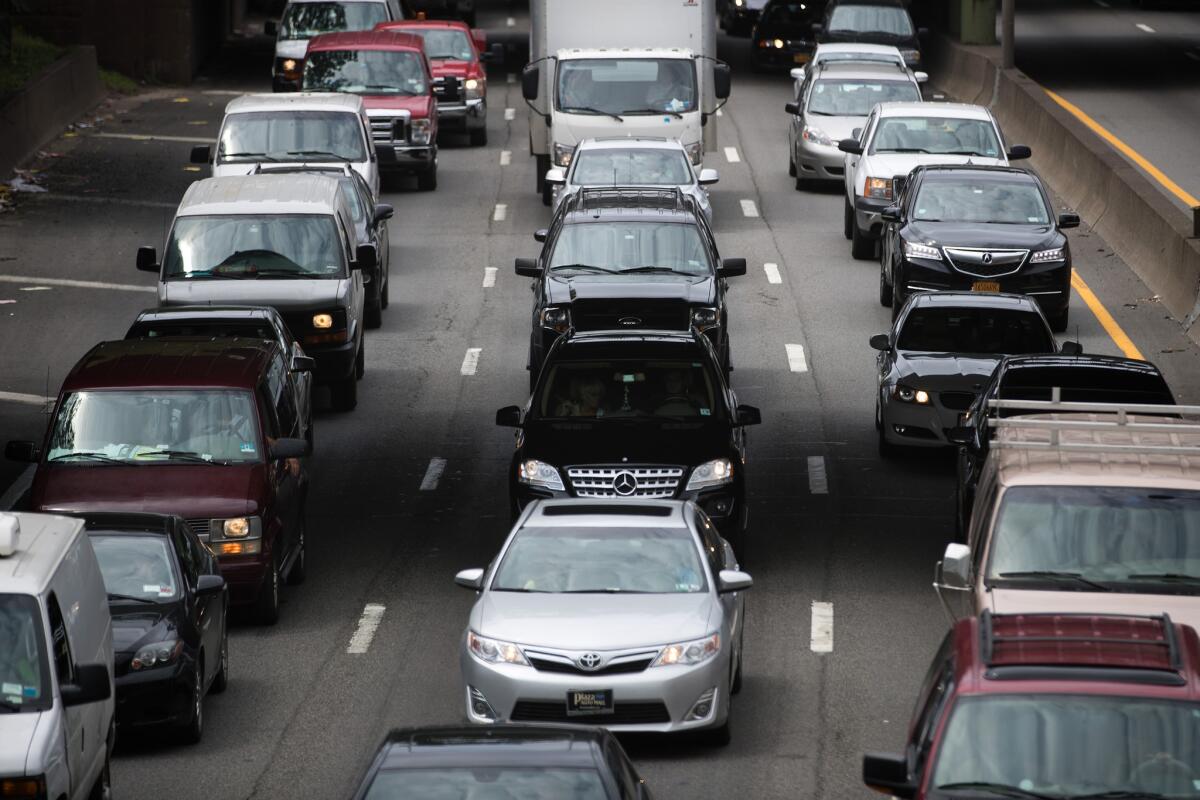Feds applaud automakers on fuel economy standards

- Share via
In a move that caught some analysts by surprise, the federal government has given the auto industry a pat on the head for its advances in meeting fuel efficiency standards.
The U.S. Department of Transportation, the Environmental Protection Agency and the California Air Resources Board made the joint announcement early Monday, saying “automotive manufacturers are innovating and bringing new technology to market at a rapid pace,” and applauding them for meeting standards proposed in a set of goals established in 2012.
Some analysts had voiced concern ahead of the announcement that continued low gas prices and consumer appetite for trucks and SUVs over higher-mileage sedans would indicate the industry was lagging behind projections.
But in their Technical Assessment Report — the three agencies studied current vehicle miles-per-gallon averages, and compared them to goals set for automobiles to be sold in the 2022-to-2025 period — the agencies gave automakers high marks.
“Today’s draft report shows that automakers are developing far more technologies to improve fuel economy and reduce greenhouse gas emissions, at similar or lower costs, than we thought possible a few years ago,” the EPA’s Janet McCabe said in a statement. “This is simply great news for consumers, manufacturers, workers and the climate.”
Third-party observers were mixed in their reaction — happy that automakers and consumers were moving in the right direction, but concerned that current success would limit future ambitions.
Dan Becker, director of the Safe Climate Campaign Center for Auto Safety, warned that forward motion in fuel economy must not be used by the federal government as a reason to weaken its demand that automakers hit a proposed goal of a 54.5 miles per gallon, set by the Obama administration, for new cars in 2025.
In comments to reporters after making their report, federal officials said that a lower goal may replace the current 54.5 mpg number.
“Rather than weaken its projections, the administration must strengthen the rules to make sure we hit the president’s goals for slashing oil use and global warming pollution,” Becker said.
Kelley Blue Book analyst Akshay Anand agreed: “Adjusting the 54.5 MPG target … shouldn’t and likely won’t stop automakers from continuing to innovate in the alternative fuel segment, as movement away from the traditional gasoline engine is inevitable at some point.”
Others were happy to note that increased federal pressure was producing positive results.
Don Anair, of the Union of Concerned Scientists, said a recent study by his organization found that 10% of all vehicles sold in the U.S. in 2015 met or exceeded fuel economy goals for 2020, suggesting the auto industry is ahead of schedule.
By offering more pure electric vehicles, plug-in hybrids and conventional hybrids, and by incorporating new technology in engines, transmissions and emissions controls, the auto industry is in fact beating expectations — thanks to the federal standards, Anair said.
“All the evidence points to the positive impact these standard have been having on increasing fuel economy and reducing emissions,” Anair said. “Consumers are getting more choices in terms of fuel efficient cars and fuel efficient trucks. The standards have driven efficiency improvements across all vehicle types.”
The EPA news release is tied to a federal plan known as the Corporate Average Fuel Economy, or CAFE, which requires automakers to hit certain efficiency standards set by the DOT. Those standards are based on average fuel economy across their total vehicle sales.
The standards, enacted by Congress is 1975, were set by the DOT but are regulated by the National Highway Traffic Safety Administration and the EPA.
This month, the federal government increased the fines it will levy against automakers for failing to meet fuel-economy standards. Starting next month, the NHTSA will be able to charge automakers fines of $14 for each 0.1 MPG below standards reached by its fleet of automobiles. The current fine is $5.50.
In recent years, according to published reports, some carmakers have paid hefty fines. NHTSA figures show that from 2010 to 2014, for example, Jaguar Land Rover was hit with $46.2 million in fines, and Daimler, the company that controls Mercedes-Benz, Daimler trucks and tiny Smart cars, paid $28.2 million.
ALSO
Elon Musk says Tesla’s autopilot feature was not on in Pennsylvania crash
California rejects Volkswagen recall for 3-liter diesel cars
Recall of dangerous Takata air bags affects 1 in 8 vehicles, report says
UPDATES:
3:50 p.m.: This article was updated with additional comments from Kelley Blue Book analyst Akshay Anand.
This article was originally published at 11:55 a.m.




